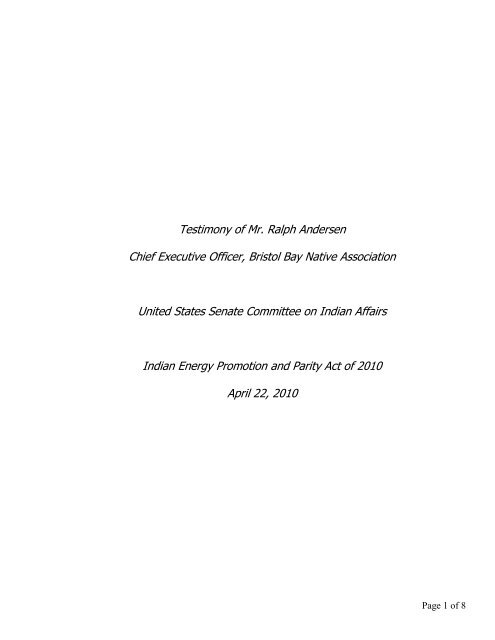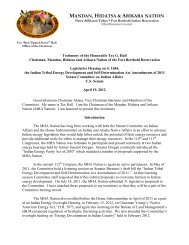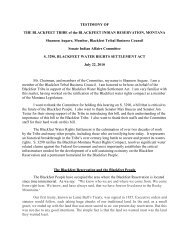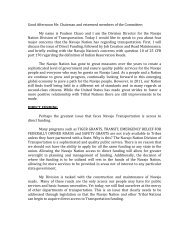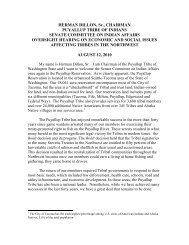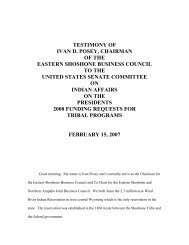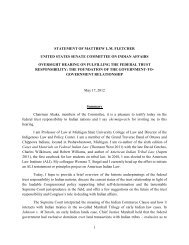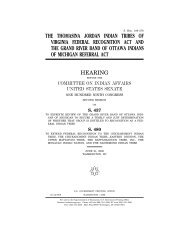Testimony - US Senate Committee on Indian Affairs
Testimony - US Senate Committee on Indian Affairs
Testimony - US Senate Committee on Indian Affairs
Create successful ePaper yourself
Turn your PDF publications into a flip-book with our unique Google optimized e-Paper software.
<str<strong>on</strong>g>Testim<strong>on</strong>y</str<strong>on</strong>g> of Mr. Ralph Andersen<br />
Chief Executive Officer, Bristol Bay Native Associati<strong>on</strong><br />
United States <str<strong>on</strong>g>Senate</str<strong>on</strong>g> <str<strong>on</strong>g>Committee</str<strong>on</strong>g> <strong>on</strong> <strong>Indian</strong> <strong>Affairs</strong><br />
<strong>Indian</strong> Energy Promoti<strong>on</strong> and Parity Act of 2010<br />
April 22, 2010<br />
Page 1 of 8
Mr. Chairman and Members of the <str<strong>on</strong>g>Committee</str<strong>on</strong>g>, Ladies and Gentlemen.<br />
Thank you for the invitati<strong>on</strong> to provide testim<strong>on</strong>y today <strong>on</strong> the Discussi<strong>on</strong> Draft of the <strong>Indian</strong><br />
Energy Promoti<strong>on</strong> and Parity Act of 2010. I am h<strong>on</strong>ored to be here today.<br />
My name is Ralph Andersen. I am the Chief Executive Officer of the Bristol Bay Native<br />
Associati<strong>on</strong> (BBNA); and co-chair of AFN’s Human Resources <str<strong>on</strong>g>Committee</str<strong>on</strong>g> composed of the Chief<br />
Executives of the 12 regi<strong>on</strong>al n<strong>on</strong>-profit c<strong>on</strong>sortiums in Alaska.<br />
I also serve as chairman of the Alaska Federati<strong>on</strong> of Natives’ Energy Working Group, and as<br />
chairman of the Bristol Bay Partnership, our leadership organizati<strong>on</strong> composed of the chief executives<br />
of the 5 regi<strong>on</strong>al organizati<strong>on</strong>s in the Bristol Bay regi<strong>on</strong> of Alaska.<br />
BBNA is a n<strong>on</strong>-profit tribal c<strong>on</strong>sortium of 31 Federally-recognized Tribes located in Southwest<br />
Alaska. Our regi<strong>on</strong> covers about 40,000 square miles and is about the size as the State of Ohio. BBNA<br />
provides a wide range of social, ec<strong>on</strong>omic, cultural, and educati<strong>on</strong>al services to benefit of the Tribes and<br />
the Native people of Bristol Bay.<br />
A comm<strong>on</strong> goal of all these organizati<strong>on</strong>s that I chair or I am involved with is to help find<br />
answers to lowering the high cost of energy in Rural Alaska.<br />
Alaska Natives – as a result of the Alaska Native Claims Settlement Act -- are the largest private<br />
landowners in our State. We have resources that can be developed – both renewable and n<strong>on</strong>renewable<br />
– and we are committed to working with state and federal governments and the private sector to help<br />
meet the energy needs of our people.<br />
Our federally recognized Tribes, our regi<strong>on</strong>al housing authorities and our regi<strong>on</strong>al Tribal<br />
c<strong>on</strong>sortia all have a str<strong>on</strong>g interest in being part of finding affordable energy and finding soluti<strong>on</strong>s to the<br />
high cost of energy.<br />
Rural Alaska faces unique energy challenges that are hard for most to imagine. We pay the<br />
highest per capita for power and fuel in the United States.<br />
The summer of 2008 was painful for us in rural Alaska. That’s when we first felt the pinch of<br />
high fuel costs. The price of crude oil went to nearly 200 dollars a barrel and the prices we pay for gas,<br />
diesel and heating fuel doubled. The high crude prices added milli<strong>on</strong>s to the state’s revenues, but<br />
emptied the bank accounts of us living in rural Alaska.<br />
In the summer of 2008, a study by the University of Alaska’s Institute of Social and Ec<strong>on</strong>omic<br />
Research showed that rural Alaskans pay 41 percent of our m<strong>on</strong>thly incomes <strong>on</strong> energy, while urban<br />
residents pay <strong>on</strong>ly 4 percent.<br />
Page 2 of 8
Last winter our hearts went out to our village people who had to choose between paying the<br />
heating oil or electricity bill or buying food for their families.<br />
Some could not afford gas for their boats or snow machines for subsistence hunting – hunting<br />
wild game -- to feed their families. We saw emergency food drops by humanitarian groups in villages<br />
across the State to keep families and children from going hungry.<br />
During the past 2 years, we’ve seen more friends, more families, and more neighbors move out<br />
of our villages and out of our regi<strong>on</strong>s because of the high cost of living. The high price of fuel is the<br />
biggest factor raising our cost of living, discouraging ec<strong>on</strong>omic and business investments, and affects<br />
every part of our lives.<br />
We are completely dependent <strong>on</strong> air and sea transportati<strong>on</strong> for supplies, groceries and fuels - the<br />
fuels we use and need for transportati<strong>on</strong>, heating and electricity needs. The rising cost and dependence<br />
<strong>on</strong> fossil fuels threatens our way of life and ec<strong>on</strong>omies as we know them. It threatens the ec<strong>on</strong>omic<br />
survival of Rural Alaska and the well-being of our people.<br />
Increases in gasoline and aviati<strong>on</strong> fuel prices caused rippling c<strong>on</strong>sequences <strong>on</strong> all aspects of our<br />
life. While Rural Alaskans may own fewer cars and trucks per capita than other Americans, we have to<br />
travel by air within and outside of our regi<strong>on</strong>s and we are heavily reliant <strong>on</strong> ATVs, snow machines, and<br />
boats for transportati<strong>on</strong>, subsistence hunting and fishing, commercial fishing, and other activities.<br />
Costs for groceries, fresh milk, a dozen eggs, airline tickets, toothpaste, medicine, baby diapers,<br />
clothes, lumber and building materials, car and truck parts – EVERYTHING – have all g<strong>on</strong>e up.<br />
Rural Alaskans are experiencing an energy crisis and we c<strong>on</strong>tinue to feel its impacts. Despite the<br />
drop in the price of crude oil we c<strong>on</strong>tinue to pay high prices. Retail prices for heating fuel range from<br />
$2.88 to $10.00 a gall<strong>on</strong>. Retail prices for gasoline range from $2.96 to $10.00 a gall<strong>on</strong>.<br />
Prices have g<strong>on</strong>e down a few dollars in some communities as the price of crude dropped, but this<br />
is not true for all of Rural Alaska. A survey of 100 communities last summer by the Alaska Department<br />
of Commerce, Community and Ec<strong>on</strong>omic Development, shows that 48 communities have experienced a<br />
decrease in retail price for heating fuel; 38 have experienced an increase and 14 have experienced no<br />
change at all. The same survey indicates that 42 communities have experienced both a decrease and<br />
increase in retail prices for gasoline, while 16 communities have experienced no change at all.<br />
Page 3 of 8
Percent Change from July 2009 for Retail Heating Fuel Prices<br />
60<br />
50<br />
48<br />
40<br />
38<br />
30<br />
20<br />
14<br />
10<br />
0<br />
Percent Change (-) Percent Change (+) Percent Change (n<strong>on</strong>e)<br />
Percent Change from July 2009 for Retail Gasoline Prices<br />
45<br />
40<br />
35<br />
30<br />
25<br />
20<br />
15<br />
10<br />
5<br />
0<br />
42 42<br />
Percent Change (-) Percent Change (+) Percent Change (n<strong>on</strong>e)<br />
16<br />
(Source: “Current Community C<strong>on</strong>diti<strong>on</strong>s: Fuel Prices across Alaska, January 2010 Update.”)<br />
Delivering fuel to Rural Alaska is complicated and expensive. There is no comparable delivery model<br />
anywhere else in the world. Fuel is transported thousands of miles from either Anchorage or Seattle.<br />
Delivery windows are narrow and often complicated by inclement weather or inhospitable c<strong>on</strong>diti<strong>on</strong>s<br />
such as low water levels needed for barges to reach Tribal communities al<strong>on</strong>g rivers and deltas. Fuel<br />
delivery arrangements are often made several m<strong>on</strong>ths in advance requiring significant financial<br />
commitments, and the inability to participate in the market fluctuati<strong>on</strong>s fully and to appreciate lower<br />
prices when available.<br />
Page 4 of 8
One way to reduce these costs and spur ec<strong>on</strong>omic development is to develop our power<br />
resources locally, become more energy efficient, and practice c<strong>on</strong>servati<strong>on</strong>. We are str<strong>on</strong>g supporters of<br />
the development of alternative energy resources, and many Rural Alaska communities are actively<br />
working towards that goal.<br />
Rural Alaska is rich in geothermal, wind, biomass, tidal and hydro but help is needed to develop<br />
them. Our state is so large and diverse that <strong>on</strong>e alternative resource may not be available elsewhere.<br />
There is no “<strong>on</strong>e-size-fits-all” answer making soluti<strong>on</strong>s more specific and expensive. We could serve as<br />
a proving ground to show how Alaska Native people and their instituti<strong>on</strong>s have the experience, capacity,<br />
and relati<strong>on</strong>ships necessary to implement workable soluti<strong>on</strong>s for the future.<br />
I offer the following comments and recommendati<strong>on</strong>s <strong>on</strong> secti<strong>on</strong>s of the discussi<strong>on</strong> draft now<br />
before you. The draft has been available to us for <strong>on</strong>ly a short period of time. We would like to provide<br />
the committee with additi<strong>on</strong>al comments and suggesti<strong>on</strong>s as the legislati<strong>on</strong> is developed. My remarks<br />
today are focused <strong>on</strong> secti<strong>on</strong>s in Title I and Title II.<br />
Title I – Energy Planning<br />
We are encouraged by the provisi<strong>on</strong>s in this secti<strong>on</strong> but believe it can be improved and<br />
strengthened by requiring tribes be c<strong>on</strong>sulted in the appointment of directors to head the <strong>Indian</strong> Energy<br />
Development Offices. This secti<strong>on</strong> should also include provisi<strong>on</strong>s for tribes or tribal c<strong>on</strong>sortia to<br />
provide the IEDO services under self-determinati<strong>on</strong> compact or c<strong>on</strong>tract agreements. Our experiences<br />
with existing BIA or DOI <strong>Indian</strong> Energy Programs have not been as beneficial as we would like. We are<br />
not sure how the energy funds they are appropriated are being spent because we do not see any<br />
solicitati<strong>on</strong>s or notices in the Federal Register or any other publicati<strong>on</strong>.<br />
We are also encouraged by the language in this secti<strong>on</strong> supporting the Tribal Energy Resource<br />
Development Organizati<strong>on</strong>s. BBNA and other regi<strong>on</strong>al tribal c<strong>on</strong>sortia in Alaska have established<br />
Tribal Energy Programs, but we lack funding to get them into full operati<strong>on</strong> or develop their full<br />
potential. BBNA’s Tribal Energy Program is charged assisting and providing informati<strong>on</strong> to tribes <strong>on</strong><br />
energy projects, initiatives and opportunities. The scope of our program is limited by limitati<strong>on</strong>s of our<br />
BIA compact, and funding my administrati<strong>on</strong> is able to dedicate each year. We desperately need<br />
additi<strong>on</strong>al funds for full program operati<strong>on</strong> <strong>on</strong> a regi<strong>on</strong>al basis. Full funding for BBNA’s Tribal Energy<br />
Program is about $750,000 per year.<br />
So<strong>on</strong> after this <str<strong>on</strong>g>Committee</str<strong>on</strong>g>’s energy oversight hearing in Bethel 2 years ago led by Senator<br />
Murkowski, we sent a funding proposal at least twice to DOI’s Tribal Energy Program. We finally<br />
Page 5 of 8
eceived a resp<strong>on</strong>se about a m<strong>on</strong>th ago that was not very encouraging. Funding to establish and<br />
maintain Tribal Energy Programs should be provided for in this secti<strong>on</strong>. Establishing 3 to 5 year pilot<br />
projects will help to prove their effectiveness.<br />
Title II, Secti<strong>on</strong> 203, Distributed Energy and Community Transmissi<strong>on</strong> Dem<strong>on</strong>strati<strong>on</strong> Projects<br />
We have offered in the past to be a part of a nati<strong>on</strong>al dem<strong>on</strong>strati<strong>on</strong> project to help reduce energy<br />
costs. We are encouraged by language in Title II, Secti<strong>on</strong> 203 calling for at least 5 distributed energy<br />
dem<strong>on</strong>strati<strong>on</strong> projects for <strong>Indian</strong> Tribes and Alaska Natives. We suggest the number of dem<strong>on</strong>strati<strong>on</strong>s<br />
should be at least doubled to 10 with a specific dollar amount of allocated over the pilot period based<br />
up<strong>on</strong> the accomplishment of certain milest<strong>on</strong>es, and the funds be distributed through P.L. 93-638<br />
compact or c<strong>on</strong>tract agreements.<br />
Rural Alaska is comprised of small, isolated transmissi<strong>on</strong> grids within each community. Many<br />
of our villages are not c<strong>on</strong>nected to each other or to a larger “energy grid” where ec<strong>on</strong>omies of scale can<br />
help keep prices down. There are a few communities closely situated that are c<strong>on</strong>nected by an electric<br />
intertie, and others close enough together where interties would be natural.<br />
In 2006 – before the energy crisis hit us -- the Bristol Bay Partnership sp<strong>on</strong>sored an Ec<strong>on</strong>omic<br />
Acti<strong>on</strong> Summit. The intent was to bring people together to find ways to create more jobs and business<br />
opportunities in our villages and in our regi<strong>on</strong>. The summit participants unanimously declared high<br />
energy costs as Public Enemy #1 and the single largest inhibitor to job and business development.<br />
In April 2009, a few m<strong>on</strong>ths before the fuel crisis hit us, the Bristol Bay Partners adopted our<br />
first Energy Policy and Crisis Recovery Plan. The Recovery Plan is focused <strong>on</strong> ways of reducing the<br />
costs of electricity, with recommendati<strong>on</strong>s to create interties between our villages.<br />
Ec<strong>on</strong>omies of scale tells us that it’s cheaper to have <strong>on</strong>e power plant generating enough<br />
electricity for 2 or 3 villages than it is to have smaller power plants in each of those villages.<br />
Studies by the Denali Commissi<strong>on</strong>, an independent federal agency, have shown that interties<br />
promote efficiency by sharing available capacity, increase the reliability of electrical power, and help<br />
reduce the cost of electricity through the use of more efficient fuels or renewable resources. Specific to<br />
Rural Alaska, interties improve the quality of life by reducing utility bills and providing for greater<br />
discreti<strong>on</strong>ary income to spend locally.<br />
Page 6 of 8
There are no existing federal programs to provide Alaska Native tribes the direct assistance<br />
needed to help us develop alternative forms of energy generati<strong>on</strong> and transmissi<strong>on</strong>. We have often in<br />
the past few years called for the establishment of an Alaska Native Energy Program in the Department<br />
of Interior or Department of Energy to provide the necessary financial and technical assistance tailored<br />
to meet the needs of Rural Alaska.<br />
We know and live with the problems. Because of our motivati<strong>on</strong> and desire for selfdeterminati<strong>on</strong>,<br />
we want to be directly involved in developing soluti<strong>on</strong>s that fit our needs. We are<br />
encouraged by the language in this secti<strong>on</strong>, but ask that the number of dem<strong>on</strong>strati<strong>on</strong>s be expanded, a<br />
fair and equitable dollar amount be identified and appropriated, and a priority be established for projects<br />
that also includes the “current price of energy.” Otherwise, Alaska Natives will again be disadvantaged<br />
and may not be able to participate in such a dem<strong>on</strong>strati<strong>on</strong> project.<br />
We successfully dem<strong>on</strong>strated our abilities and the effectiveness of operating BIA programs<br />
under P.L. 93-638 compact agreements. We successfully dem<strong>on</strong>strated our abilities and the<br />
effectiveness of operating programs under P.L. 102-477 through our 638 compacts. I am very c<strong>on</strong>fident<br />
that we can successfully dem<strong>on</strong>strate operating programs under the legislati<strong>on</strong> now before you.<br />
Title II, Secti<strong>on</strong> 206, Inclusi<strong>on</strong> of <strong>Indian</strong> Tribes in State Energy C<strong>on</strong>servati<strong>on</strong> Plan Program<br />
In general, there are no programs funded that support Tribal energy efficiency and c<strong>on</strong>servati<strong>on</strong><br />
efforts. The Energy Efficiency and C<strong>on</strong>servati<strong>on</strong> Block Grant established in the Energy Independence<br />
and Security Act of 2007 was left unfunded until the American Recovery and Reinvestment Act of<br />
2009. This block grant calls for direct funding to local, state and Tribal governments to develop and<br />
implement projects to improve energy efficiency, reduce energy use and fossil fuel emissi<strong>on</strong>s. This<br />
same Act authorized $2 billi<strong>on</strong> in annual appropriati<strong>on</strong>s over a five-year period, and was not intended to<br />
supplant other federal funding dedicated to efficiency, c<strong>on</strong>servati<strong>on</strong> and weatherizati<strong>on</strong>.<br />
Regardless of the future prospects and funding of the EECBG, we support the inclusi<strong>on</strong> of a 5<br />
percent Tribal set-aside of the State Energy C<strong>on</strong>servati<strong>on</strong> Plan Program, and a more established funding<br />
opportunity within the Department of Energy.<br />
In accordance with a Tribal set-aside, we request Tribal representati<strong>on</strong> <strong>on</strong> the State Energy<br />
Advisory Board. This board develops recommendati<strong>on</strong>s for the Department of Energy and the C<strong>on</strong>gress<br />
regarding initiati<strong>on</strong>, design, implementati<strong>on</strong>, and evaluati<strong>on</strong> of federal energy efficiency and renewable<br />
energy programs. We request being involved in these processes and be directly involved in decisi<strong>on</strong>s<br />
affecting our lives.<br />
Page 7 of 8
I believe str<strong>on</strong>gly that in these modern times of the 21 st century, the days of decisi<strong>on</strong>s being<br />
made out of our view, in far away places, by people we d<strong>on</strong>’t know and never see, and without our<br />
involvement, are l<strong>on</strong>g passed.<br />
Title II, Secti<strong>on</strong> 207, Home Weatherizati<strong>on</strong> Assistance<br />
The Department of Energy’s Home Weatherizati<strong>on</strong> Assistance Program is minimally funded<br />
compared to the vast need in our nati<strong>on</strong>. Alaska is fortunate in that the DOE funds have historically<br />
been used by the five recognized c<strong>on</strong>tractors for the State for housing in our villages. In additi<strong>on</strong>,<br />
the Alaska Legislature has funded a program mirrored <strong>on</strong> the Federal Program, with funds allocated to<br />
the five recognized c<strong>on</strong>tractors receiving Federal DOE funds, but also to 14 Native Tribal Housing<br />
Authorities in the State.<br />
Even with these new resources reaching our tribes, the need far exceeds available resources. In<br />
Bristol Bay, approximately 1300 of 2500 homes in the regi<strong>on</strong> are classified as low income according to<br />
the income guidelines. The need for weatherizati<strong>on</strong> <strong>on</strong> low-income homes exceeds $50 milli<strong>on</strong>. Of the<br />
1300 homes, with a mix of state and federal funding – we are able to weatherize 100 homes per year. If<br />
we relied strictly federal funds, we would be able to weatherize and repair <strong>on</strong>ly 20 homes per year.<br />
Current available resources will fund 10% of the $50 milli<strong>on</strong> needed, leaving a 90% gap. It is<br />
this gap that must be filled.<br />
That c<strong>on</strong>cludes my formal testim<strong>on</strong>y. Because the bill before you is a discussi<strong>on</strong> draft at this<br />
point, I respectfully request that Alaska Native tribes and tribal c<strong>on</strong>sortia are allowed to submit written<br />
comments and recommendati<strong>on</strong>s. We request to be involved in the process as this important legislati<strong>on</strong><br />
moves forward.<br />
I will be happy to answer any questi<strong>on</strong>s you may have.<br />
Thank you.<br />
Page 8 of 8


